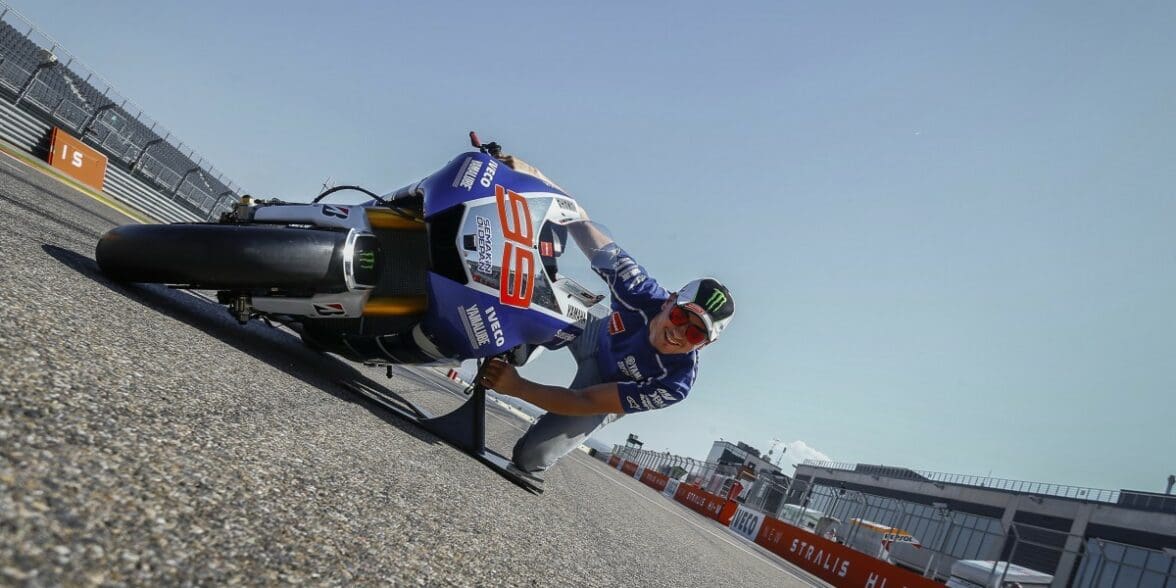The picture I’ve placed above is an interesting one. For those not in the know, it’s an image from the “MotoGP Lean Angle Experience.” Long story short, it allows regular punters like you and I to experience what it’s like to lean at a purported 64°, just like our collective racing heroes a.k.a. Rossi, Márquez and Miller. And while it may just seem like a pleasant way to waste 15 minutes at your local MotoGP event in between the races, it’s actually a genius idea that does something very important in terms of motorcycle rider training.
See, as we all know far too well, the real challenge with learning about motorcycle physics is that if you get it wrong, you can end up seriously hurting yourself in a motorcycle crash. Compare that to something like cooking or music, where mistakes are just annoying occurrences that you make, figure out and move on from.
But make a proper mistake in the world of motorcycling and the consequences can be hospital, permanent disability, or even a one-way trip to the big MotoGP racetrack in the sky. The result of this game’s high-stakes is that most riders treat the art of riding a bike kind of like a game of Russian roulette—and rightly so. No one should try and get their knee down during their very first ride on a bike. That would be insane.
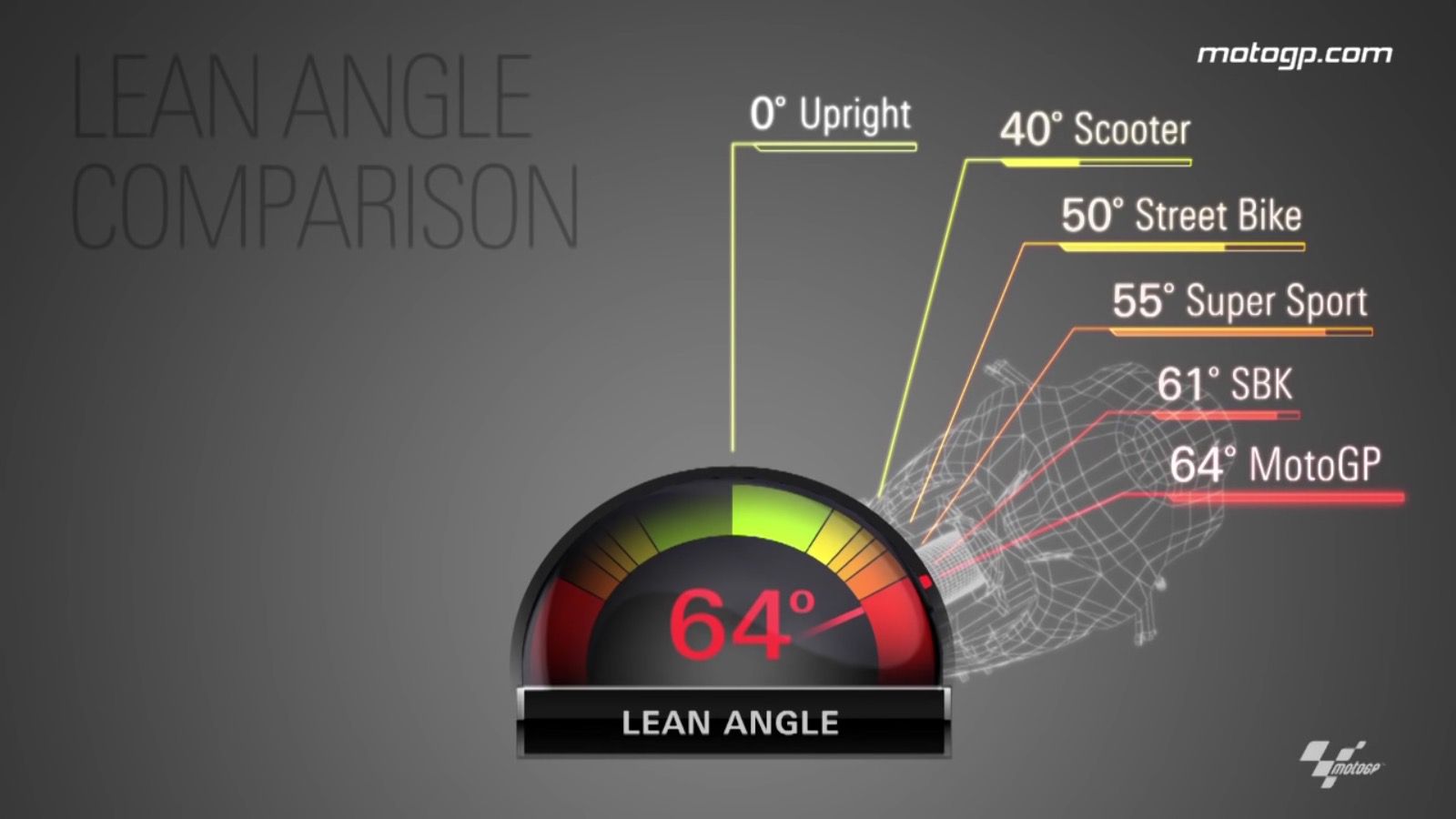
But what this big “bike on a hinge” attraction at the Moto GP does is allow people to push the limits of motorcycle physics safely; it shows them what happens when a bike leans and provides a greater level of understanding regarding the forces at play. It also breaks down the process into something easy and memorable—and most importantly, it lets participants understand what happens when a bike leans without them actually having to attempt a similar move at high speed.
In essence, they are learning the theory of movement and physical interactions before putting it into practice. That, my custom leather race suit wearing friends, is what they call physics.
So let’s put our moto mortar board hats on and look at what actually is happening when you ride your beloved motorbike down the road and through a set of corners. I’m going to break this whole she-bang down into three main parts: acceleration, braking, and cornering.
Naturally, cornering is the big daddy when it comes to physical forces, so let’s leave that one to last for when you’re properly warmed up.
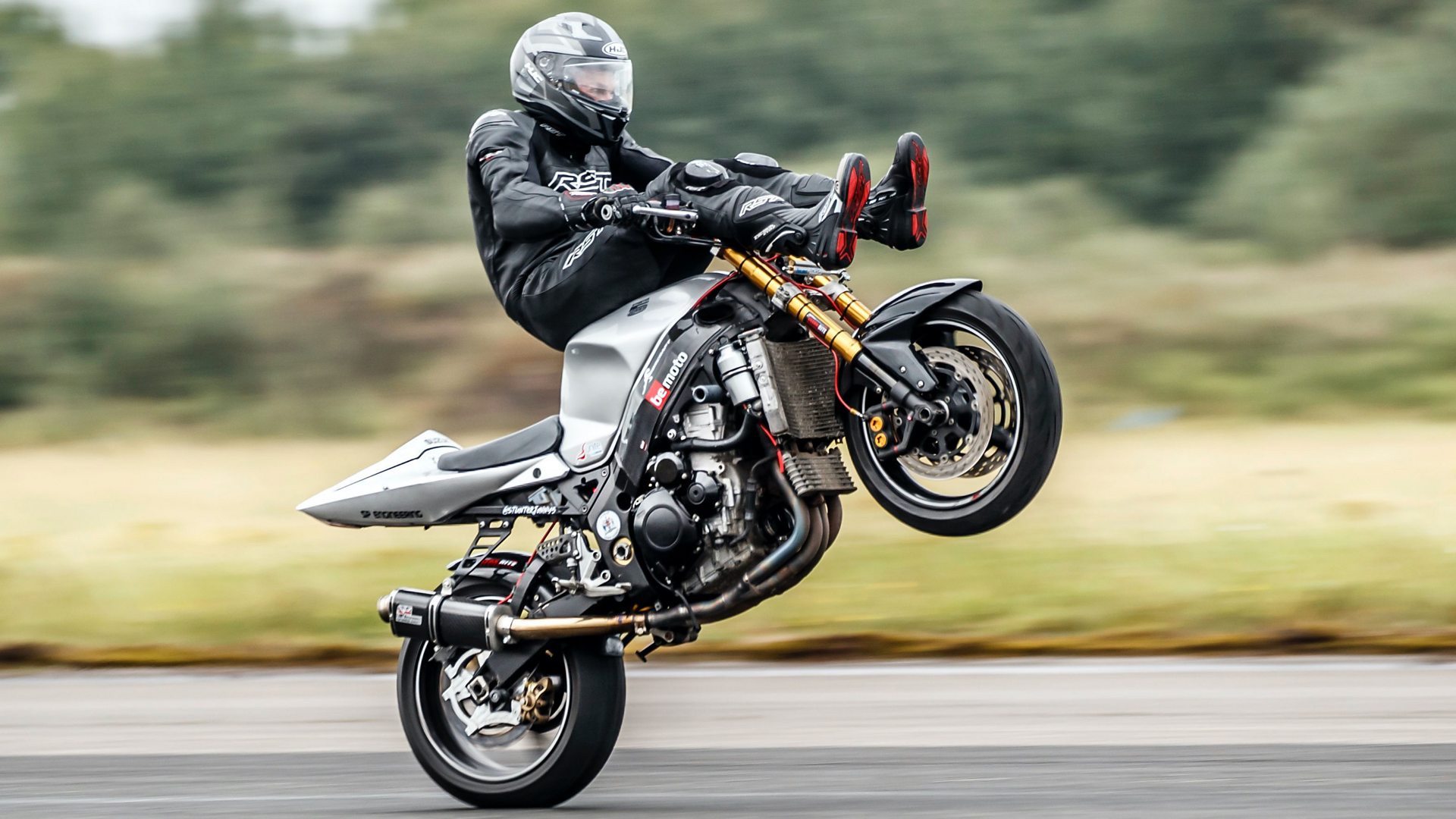
1. Acceleration Physics
What we are doing here is bringing a common, garden-variety motorcycle from a standstill up to a comfortable cruising speed. Needless to say, at a standstill and with the engine turned off, a motorcycle only has one main force acting on it, and that’s gravity.
Gravity & Torque
Go ahead and turn the engine on. It now has two forces acting on it: gravity and a large rotating mass spinning inside of it. Put simply the pistons, crankshaft and other assorted gubbins that form the rotating mass inside an engine create “torque” (a force that can cause an object to rotate about an axis). Rev the engine and Sir Issac Newton’s third law kicks in here—and it states that “For every action (or force) in nature there is an equal and opposite reaction.”
In this case, as the engine spins up, it also exerts an equal and opposite force on the bike itself. In the case of my BMW and its boxer engine, when I rev the engine at a standstill, the entire bike rocks to the right. This is, in fact, the counter-clockwise rotation of the engine’s crankshaft pushing against the rest of the bike and trying to spin the entire bike in a clockwise direction.
Thanks to gravity, the crank’s rotational axis, and the fact that the bike is resting on the ground, this force translates to the top of the bike moving to the right.
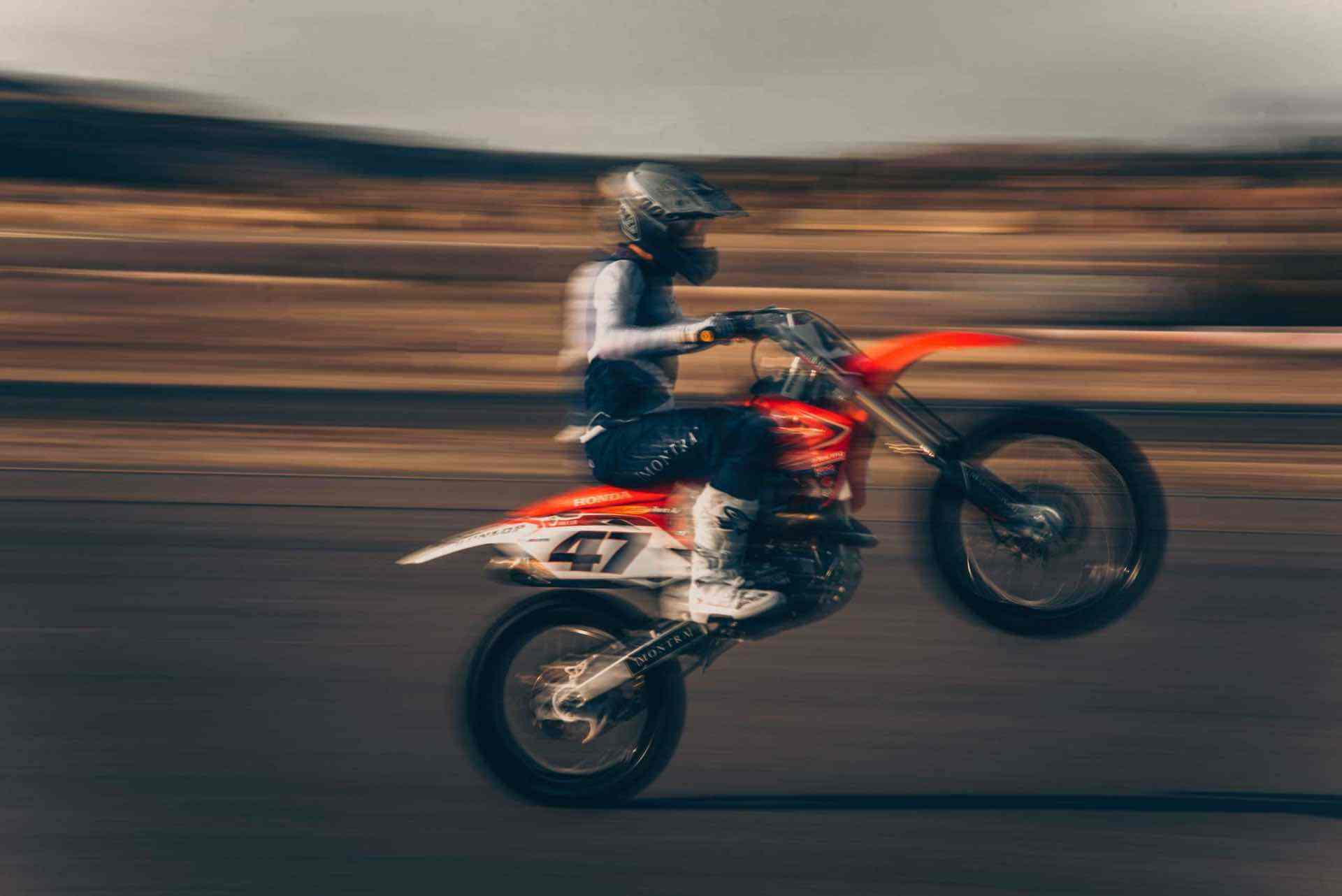
But the best “opposite forces” here are the ones that propel you and your bike forward, namely the ones that this very same spinning engine is imparting on the rear wheel. It does this by pushing the bike forward and in another example of Newton’s third law, it also sees the bike itself push against the road, or if you want to be really dramatic about it, it’s actually the bike trying to spin the entire planet in the equal and opposite direction to the bike’s direction of forward travel.
Take this idea to its logical conclusion, and a bike that had enough mass and torque could stop and/or change the planet’s spin—but that’s a Friday beers conversation we’re not going to have here.
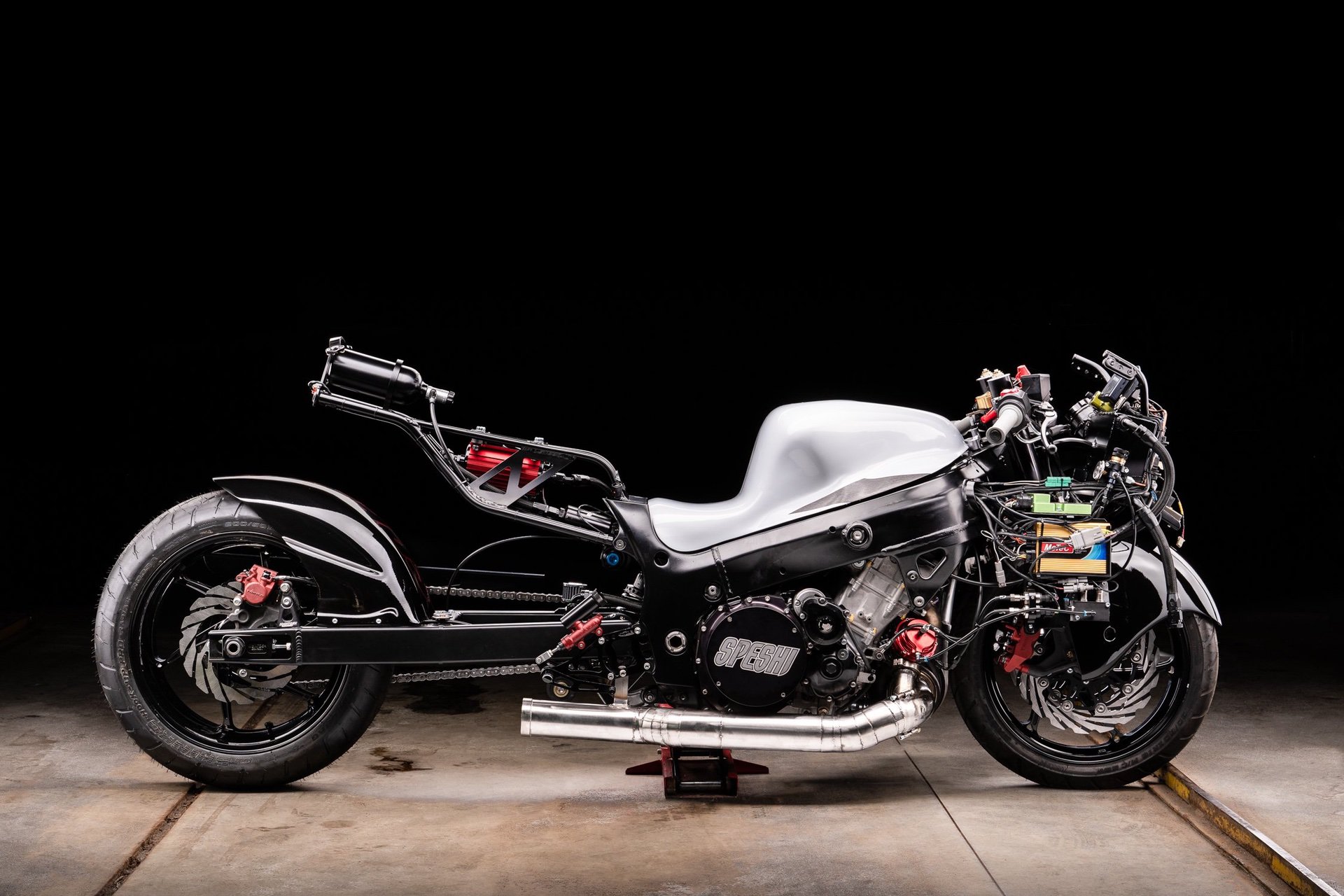
So basically, the force of the engine turning is transmitted to the rear wheel, which pushes against the road and moves the bike forward. And as most motorcycles have a fairly short wheelbase as compared to their centre of gravity and its distance above the road’s surface, a motorcycle that has enough torque applied to its rear wheel will eventually raise its front wheel off the ground.
This is why drag bikes tend to sit low and have very long rear swingarms: the longer the wheelbase of the bike, the harder it is for the torque pumping out of the rear wheel to lift the bike’s front off the ground. And in drag bikes, it’s all about how much force you can impart to the ground without looping the bike and having the thing land on top of you; hence their epic length.
Why Motorcycles Stabilize As You Ride
The other force that comes into play at this point is the force of the bike’s two wheels spinning. Now, unlike the turning force of the engine, this force isn’t just present under acceleration. Instead, it is present at all times and is entirely reliant on the speed that both the wheels are spinning at. A motorcycle won’t want to wheelie if you are cruising at a constant speed, but the angular momentum generated by the mass of the spinning wheels and tyres is constant. And thanks to the rules of conservation of angular momentum, the bike’s spinning wheels will tend to keep the motorcycle upright and travelling in a straight line.
Don’t believe me? Then think about how many times you have seen a MotoGP rider have an off only to see their bike right itself and continue on in a straight line until it hits a barrier. That, my friends, is the wheels conserving angular momentum. And how many of you have seen a stationary bike stand up by itself without a stand? Exactly none, right? Again, that’s because the bike’s wheels are not spinning—and therefore there are exactly no forces at work apart from gravity.
The final main force here is also regarding good ol’ Newton. He also stated that objects at rest will remain at rest. So when you apply the throttle and the bike moves off, your body will want to stay stationary. At gentle accelerations this is barely perceptible, but if you really give it some beans, the bike will launch forward and you will get the feeling of your body wanting to slide backward off the bike.
The most natural reaction here is to tighten your grip on the bars, but guess what? That’s right, your primary handhold on the bike is also the throttle; and that’s that part that makes the bike go faster. Ever heard of whiskey throttle? Boom.
The other (albeit more minor) force at play here is wind resistance, which also pushes against you and the bike. But we won’t go into that here because unless you plan on a session at the local race track, the forces aren’t enough to have any meaningful effect at regular speeds. Certainly not one that’ll endanger you.
ACCELERATION SAFETY LESSON: During acceleration, torque forces will counteract the force of gravity keeping your bike’s front wheel on the road, reducing the effectiveness of the steering and possibly raising the front wheel off the ground. The force of a motorcycle’s spinning wheels keeps the bike upright and wanting to head straight. Your body will want to “stay behind” when your motorcycle accelerates, affecting your posture, grip on the bars and how much throttle you are applying.
2. Braking Physics
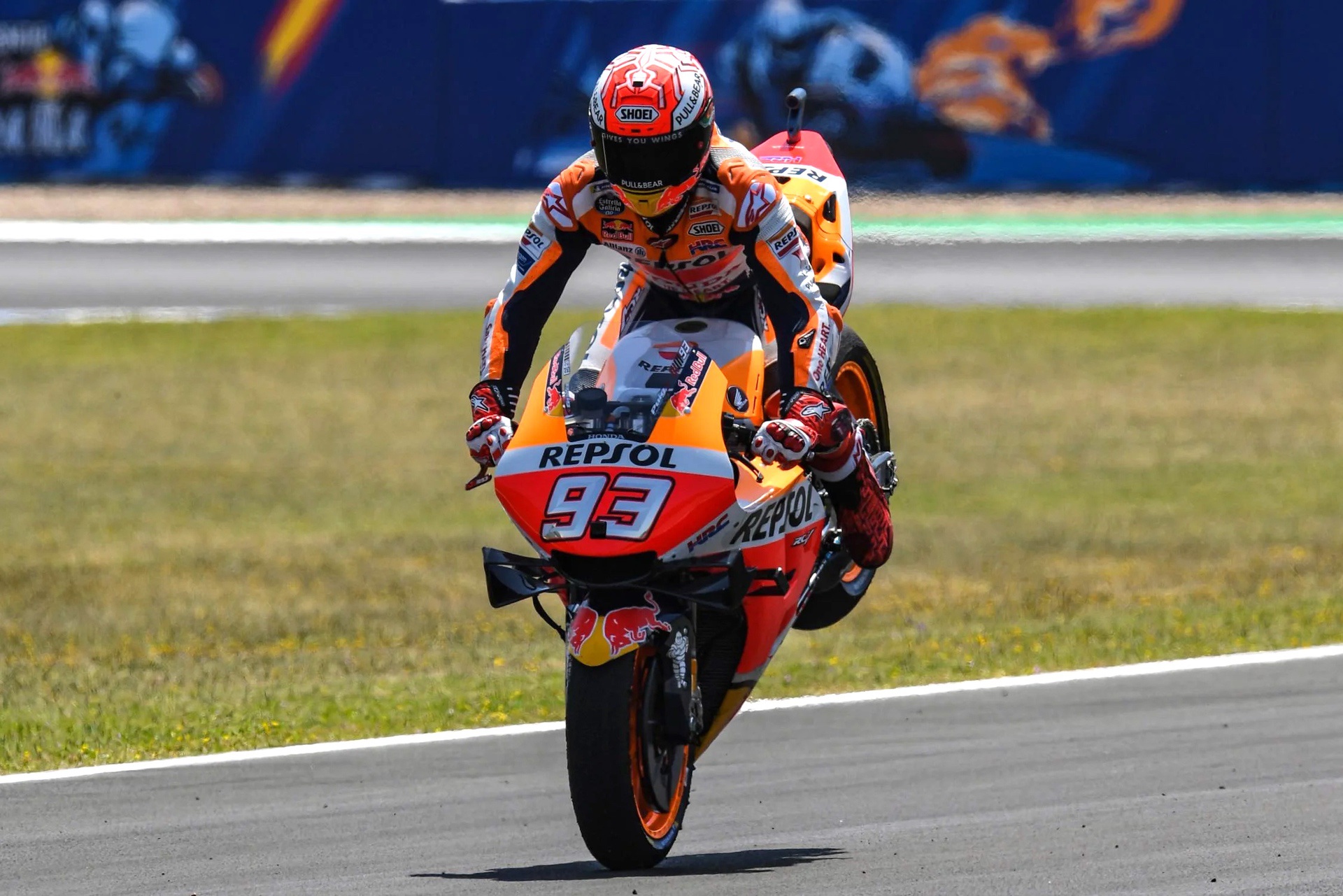
I’ll avoid repeating myself here, so rest assured that a bike will always have the force of gravity pushing it downwards and if it’s moving, the wheels will have angular momentum. But what happens when you apply the brakes on a bike? Funnily enough, it’s pretty much the exact opposite of what happens when you accelerate hard. If you think about it, a bike under hard acceleration will wheelie, but what does a bike under hard braking do? That’s right, it’ll do a reverse wheelie, or a “stoppie”. Fun if you are expecting it and can control it, but super dangerous and even deadly if you aren’t.
Friction & Inertia
When you apply the brakes with enough force, the friction that occurs between the front tyre and the road’s surface does the opposite to the bike that engine torque does; as the bike’s centre of gravity is above the road’s surface, it will tend to try and rotate the entire bike around the point where the tyre is in contact with the road because the bike’s mass is above that point. Again, if the bike was as long and low as a car, this wouldn’t happen.
The very same forces lift the rear wheel off the ground, really reducing its effectiveness in the overall stopping equation. In cars, the weight distribution is different, so you’ll never see a car do an emergency braking manoeuvre and flip on its roof. Instead you’ll just see it dive so the nose goes down and the rear comes up. Likewise, a car under strong acceleration forces will raise its nose and squat at the back.
Like on cars, ABS—or anti-lock braking systems—on bikes stops your wheels from locking up entirely under heavy braking. For cars, this is important as you can’t steer a car with locked wheels. But as an additional bonus on bikes, it’ll also stop you from being launched over the bars of a bike that otherwise would have done a spontaneous cartwheel. Make no mistakes, a full emergency stop on a motorcycle is a very dangerous and avoid-at-all costs event, but it’s good to know that ABS has your back (and your hands, face, legs and arms) if it does happen.
The other “same but opposite” force here is the one where your body that’s in motion will want to stay in motion. So instead of being forced off the back of the bike as with acceleration, here you’ll be forced forwards towards the handlebars as the bike slows and you don’t. Luckily there’s no opposite to whisky throttle (no, vodka braking is not a thing) and your average riding posture means that it’s a lot easier to deal with braking forces simply by pushing against the bars than it is for “pulling” acceleration forces.
BRAKING SAFETY LESSONS: Hard braking on a bike without ABS will raise the rear wheel and possibly throw you over the handlebars. Of all the emergency situations that can occur on a bike, hard braking is the one you want to avoid the most. If there’s real speed involved, it will almost always put you in serious danger. And despite what seasoned bikers will tell you, it’s incredibly hard to modulate your braking force on a non-ABS motorcycle in an emergency. 95% of riders—even the good ones—will just apply all the brake at once given a big enough scare.
3. Cornering Physics
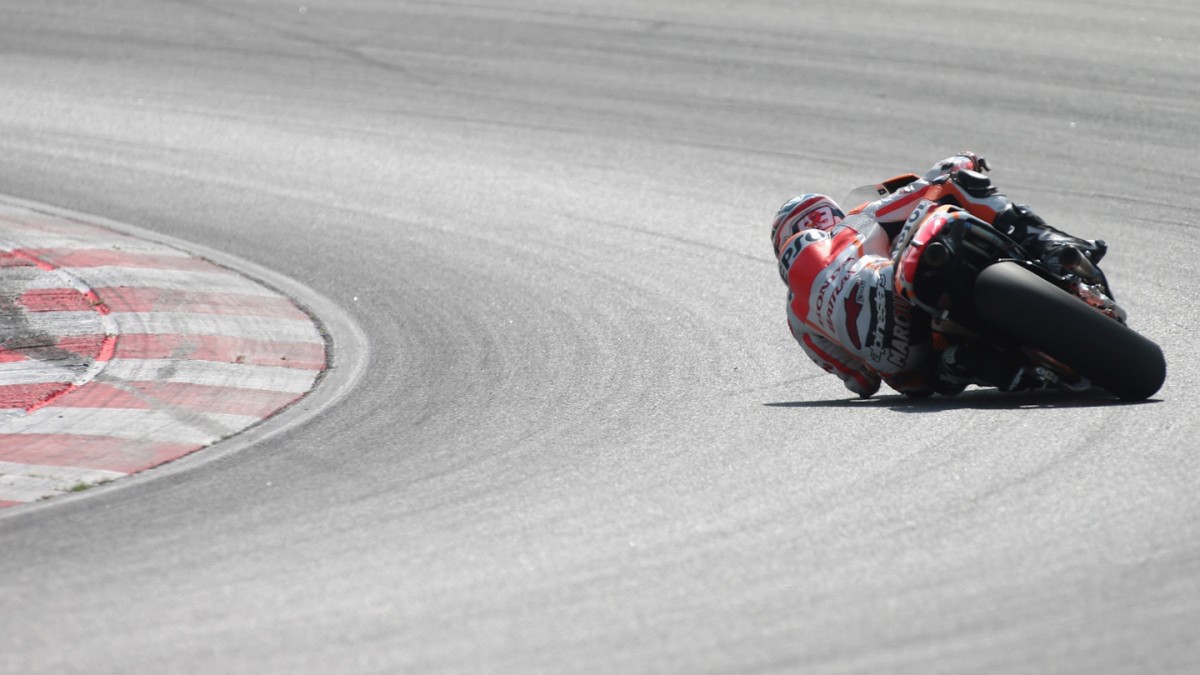


OK. This is where the rubber REALLY hits the road. The physics involved in cornering a bike are super complex, so we’ll only cover off the most important ones here. Sharpen your imaginary pencils and pay attention. It could save your life.
Picture a snapshot of a motorcycle taken mid-corner. These aren’t your average urban corners, either. While the physics are largely the same, for the sake of argument, let’s imagine a big sweeping rural corner. The ones that last more than a few seconds and see you and the bike leaned over a good amount. Here there are three main forces at play.
Equilibrium (Balance) & Centrifugal Force
At this imaginary frozen moment, the bike is leaned over at (say) 45 degrees. Now obviously if you did that while stationary and with your feet on the pegs, the bike would just come crashing down. But why doesn’t it? It’s because there is an equilibrium—or balance—of forces pulling the bike downwards (gravity) and wanting to push it upright. This upright one is a “centrifugal” force. Centrifugal quite literally means “centre fleeing”; and now you can see why. This force pushes you away from the centre of the turn.
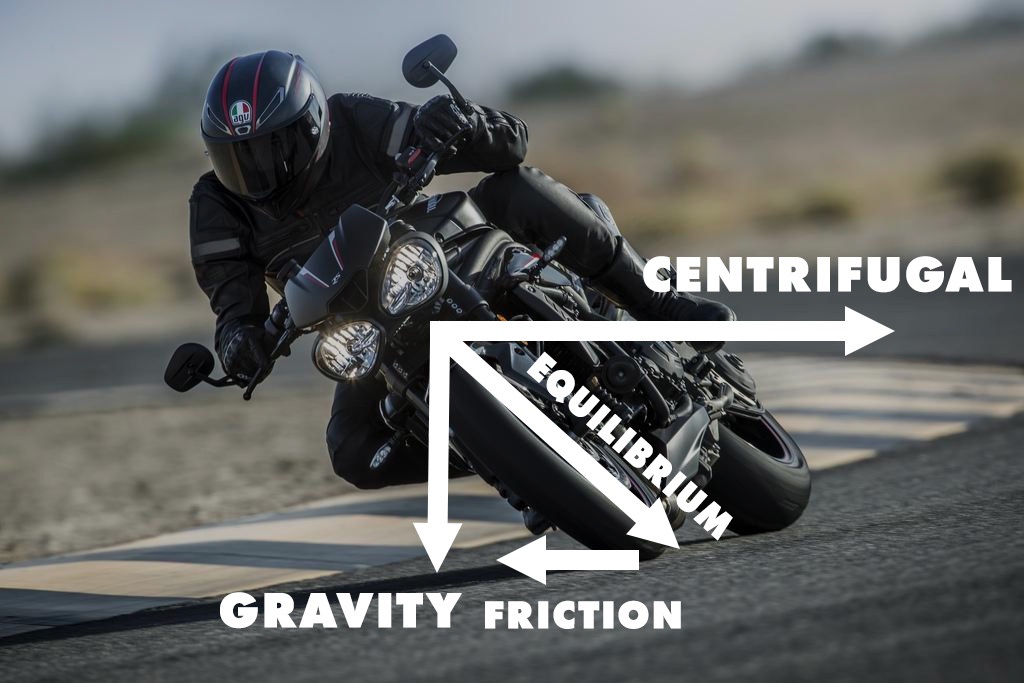


In short, the lean the rider imparts on the bike by their inputs into the ’bars and transferring their bodyweight to the inside of the corner counteracts the force that wants you and the bike to be launched off the road and into the undergrowth like a kid on a merry-go-round that’s been spun up too fast.
The life-saving force here is of course the friction between the bike’s wheels and the road. It’s the same friction that also helps your wheels rise off the road when pinning the throttle and smashing the brakes above, so just when you think friction maybe kinda sucks, here it is saving your life. No friction, no cornering.
And all that’s only considering the forces at play in one axis of a bike leaning. Now imagine looking at all the other forces at play. The wind resistance pushing you and the bike backwards. The angular momentum of the spinning wheels wanting to sit the bike upright and keep it going in a straight line. And to all that, you can add the angular momentum and torque forces at play as the engine in the bike changes both revs and undergoes changes of angular momentum as its spinning mass is moved around. And what about the whole countersteering thing? My god. The helmeted mind boggles.
Now you can probably start to picture why it’s really not a good idea to brake hard mid-corner. Or accelerate hard. Adding a rapid change in speed and friction to this already complex equation and all hell will break loose.
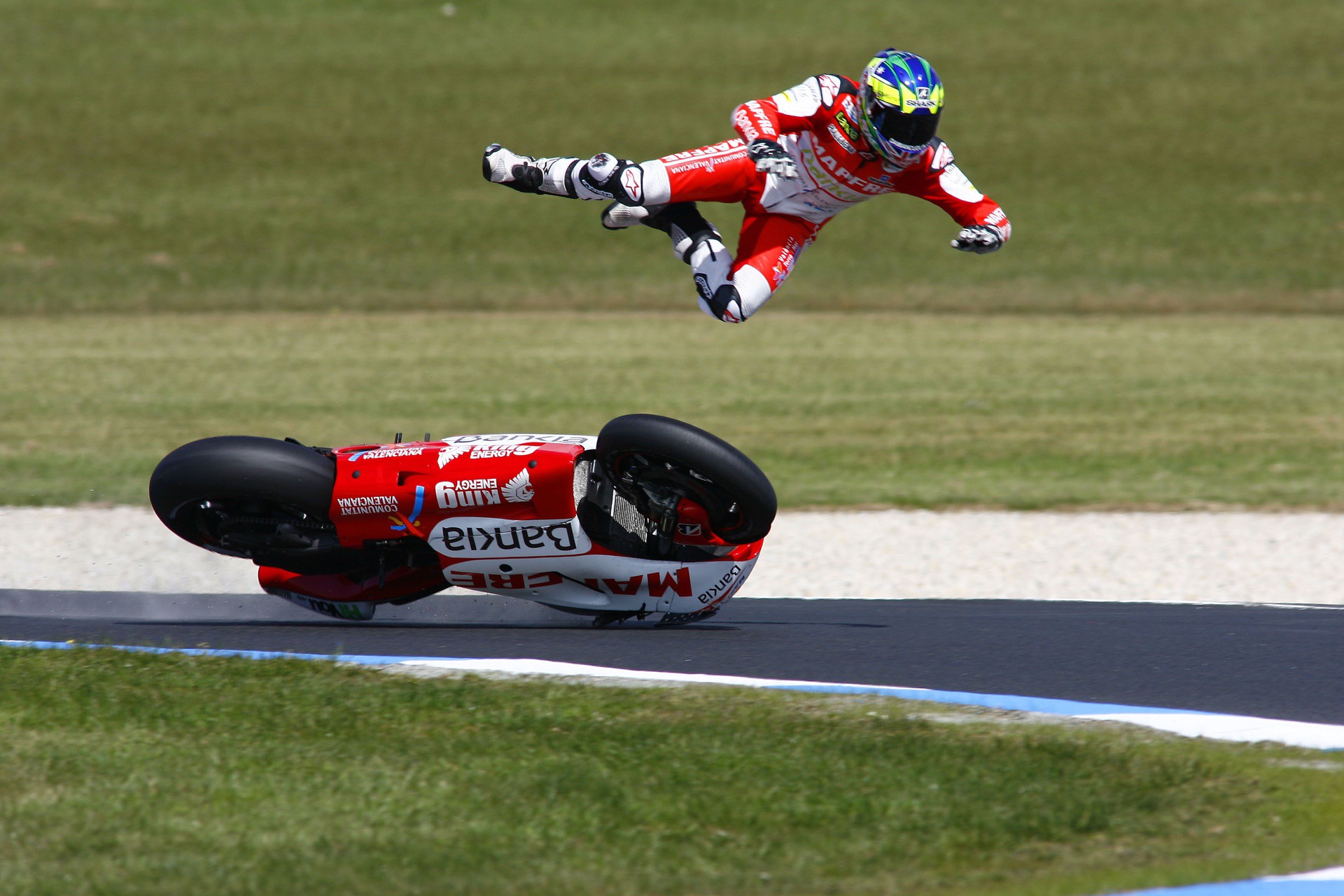


In the end, the fact that motorcycles can corner at all now seems kind of remarkable, doesn’t it? It’s also mindblowing to know just how far you can take this whole equation when you look at a MotoGP bike cornering. Them getting their knees, elbows and even helmets (gulp) to touch the ground is nothing more than an attempt by the riders to reach a cornering equilibrium, but in this case that balance allows them to corner faster without being thrown off.
Similarly, if you wanted to build the world’s fastest MotoGP bike, all you’d need to do would be to allow it to lean over further than the 64 degrees we referenced at the start of this piece.
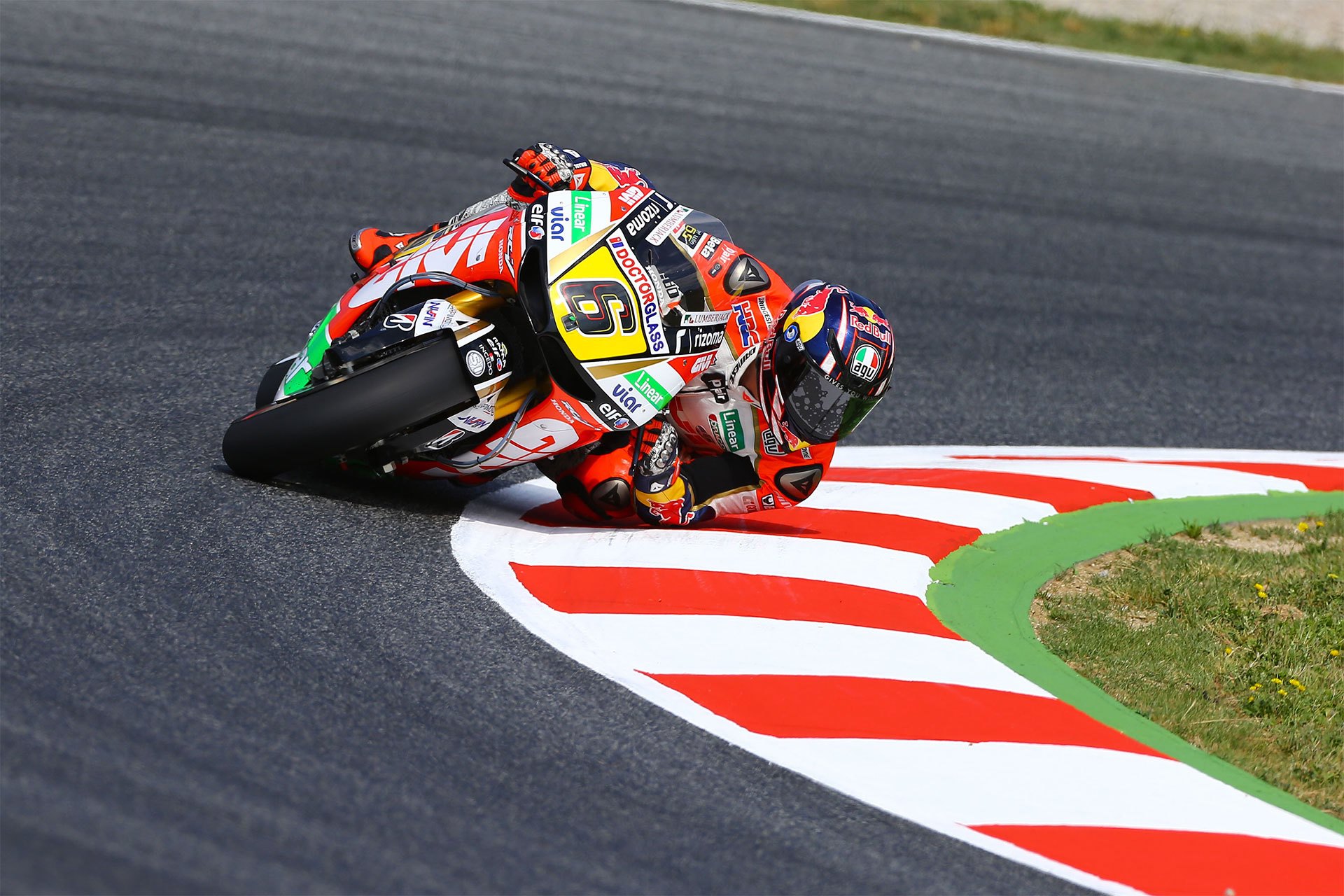


As the speed through the corner increases, so do the Centrifugal forces wanting to toss you off. Balance that with a greater lean angle—hence allowing more gravity to come into play to balance the centre fleeing—and you, my friends, now have a race winning bike. If you could just figure out how to keep enough rubber on the road, where to put the rider’s feet and how to design a bike that looks like an upside down pyramid.
Put it all together properly and this is what physics (and a buttload of skill) can do.
CORNERING SAFETY LESSONS: Cornering a motorcycle is about balancing your lean angle (i.e. the force gravity is pulling over the leaning bike) with the centrifugal forces trying to lift the bike up and push you to the outside of the corner. A large percentage of cornering accidents occur with the phenomena of target fixation; a condition where a rider loses faith in the bike’s ability to corner and returns it to an upright position, therefore running wide. Always look through a corner and never into it, and never make any sudden applications of brake, throttle or steering once you have committed to a corner. Remember that the weakest link in the chain is you; almost all motorcycles can corner much harder than you can.


